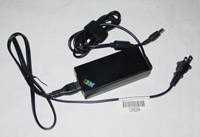IBM/Lenovo ThinkPad R52
Construction: Field Tested
|
Charger –For years, IBM has stuck with the same power brick. Like Dell's, it remains one of the better charger designs on the market, particularly with the strap design that allows you to tie up extra cabling and the straight power plug that has thus far always been plugged in the back of the notebook. The only down side is that it is pretty hard to tie up extra cabling on the AC end of the power brick, because it doesn't use a right angle design like Dell.
Display –IBM offers three display options for the R52: 14.1" XGA (native 1024 x 768), 15.0" XGA (native 1024 x 768), 15.0" SXGA+ (native 1400 x 1050). Of the four R52 Express models there is only one that uses a 14.1" display. The rest come with a 15.0" XGA display. Personally, we feel that a 15.0" XGA screen just looks awkward, so we recommend the 14.1" display model (you cannot chose between display sizes for those Express models at the moment). If you prefer the larger 15.0" display size, however, we recommend the SXGA+ (1400 x 1050) model. All of the displays have a fairly good viewing angle, so the person sitting next to you can probably see what you are looking at with the brightness setting at max (8).
With 8 brightness settings, the display has a fairly good range from bright to dim. The dimmest setting is a bit too dark for us to be comfortable to use in a dark room, but it would do just fine if you aren't interacting but need to conserve battery life while monitoring what is going on. The brightest setting isn't super bright, but it bright, sharp, and generally better than the 14.1" or 15.0" XGA display panels we've see on some other notebooks. In a dark room, you are better off at level 2 or 3 if you don't want to strain your eyes.
On a side note, this display is one of a few that allows for a wide range of virtual display resolutions. Normally, we only see the max resolution of 1600 x 1200 or 1920 x 1600, and that is only on the rare occasion when we see displays that are capable of virtual resolutions, by comparison, our R52 sample came with the max virtual resolution of 2048 x 1536.
Fan - For the majority of time we were running through our benchmarks, the notebook was fairly quiet, other than the almost inaudible hum of the hard drive. The fan comes on intermittently, but it is just as inaudible as the hard drive; kind of like a whispery whirl. In a typically computer room, you would have to put your ear within an inch or so of the keyboard in order to hear the fan. In dead quiet library, the person next to you should be able to barely hear the fan at min speed. In our field testing, we tried to watch a Divx encoded movie off our 802.11g network (CPU load - 15% to 20%). About 15 minutes into the movie, the fan immediately came on and went to max speed. In the next 3 to 6 seconds, the fan slowed down to min speed. Keep in mind that we don't just do performance testing, we also do a lot of field and usability testing.
When the fan went to max speed, it was louder than the hum from the hard drive but it was not as loud as the optical drive when accessing a DVD. The maximum volume of the R52's fan is quieter than most other notebooks. Generally, it only went to max speed when the notebook was getting into CPU intensive loads, and only for short periods of time when it did. If you are just milling through your "run of the day" computer routines: e-mail, word processing, browsing, etc, you will likely find this to be a very quiet notebook. IBM got this design right, of course the increased real estate space of the R series platform helps displace heat efficiently.
Heat – After about three plus hours of use, the notebook was still relatively cool to the touch. The only place that got warm was the bottom of the notebook where the CPU (roughly below the "c" key), northbridge (right of CPU), and WiFi card were situated (below touchpad). Compared to other notebooks, this stays cooler than most of them. But keep in mind that constant full-load CPU operations will increase temperatures.







